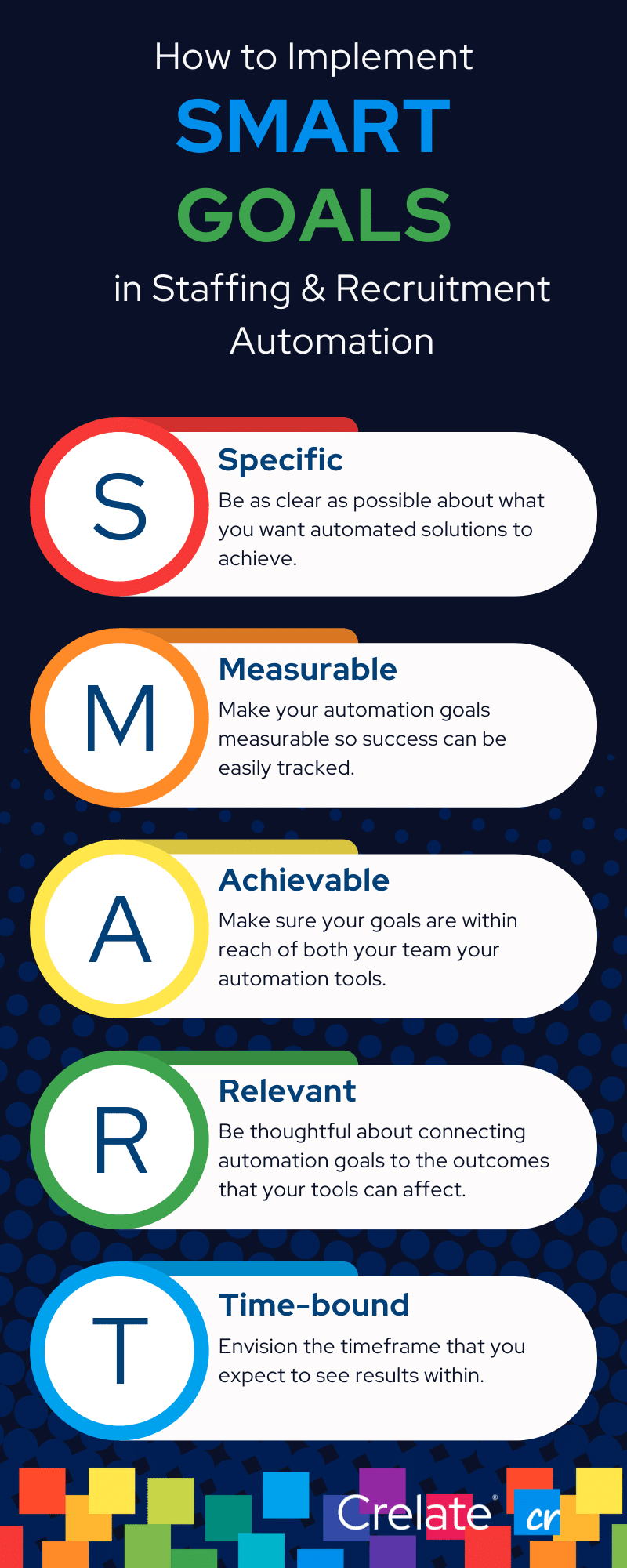
People are talking about automation and artificial intelligence everywhere you turn these days—and with good reason. We’re living through a sea change in what technology empowers us to do.
With thoughtful automation, staffing and recruiting firms are offloading their team’s busywork, which gives their recruiters more time to spend building relationships.
And with powerful advances in AI like ChatGPT and natural language processing, businesses are finding new ways every day to streamline their workflows, save time and energy, and improve their bottom lines.
However, in this mad dash to automate as much as possible as quickly as possible, some agencies are missing the mark. Here are some of the most common automation mistakes staffing leaders make – and how to solve them.
1. Not defining your goals for automation
With all the excitement about AI and automation, it’s easy to think that 100% automation is the #1 goal for businesses today.
But, automation isn’t a goal. It’s a solution to help you and your team achieve your goals.
Letting technology – and the desire for the fastest, shiniest new tool – lead your decision-making can create bloated systems that don’t serve your agency’s needs. Automation for automation’s sake can waste time, energy, and money – resources that could’ve been saved by setting clear goals.
What’s more, automation is built for speed. As a result, adopting automation without defining what exactly you want your tech to achieve can lead you in the wrong direction very, very quickly.
The fix: Be thoughtful about setting the goals you’d like to reach through automation.
To be sure you don’t automate yourself into oblivion, anchor all implementation decisions to what you’d like your technology to achieve.
For example, if you have a goal to make your recruiting team less transactional, tapping ChatGPT to write your candidate outreach may not align with that goal.
Instead, you should focus on adopting the marketing automation tools that will help free your recruiters’ time up to write the kind of highly personal outreach that builds trust with candidates and helps them feel seen and heard.
You also want to set appropriate benchmarks for your automation efforts, which are tied to your higher-level goals. As with any new tech solution, you want to ensure that it operates as promised and serves your company’s growth.
Here are some examples of effective automation goals:
- Marketing automation software goal: Reach 1,000 new candidates monthly via email campaigns and achieve an email open rate of over 30%.
- ChatGPT goal: Save each recruiter 3 hours weekly on candidate and employee correspondence.
- CRM goal: Improve recruiter response time by 20% with real-time task management within three months.
By implementing SMART goals – specific, measurable, achievable, relevant, and time-bound – you give your team a clear picture of what successful automation looks like.

2. Not getting buy-in from your team in automation
As with most tech solutions, your team will be on the implementation frontlines. They will have a massive influence on whether a new initiative succeeds or fails.
If you make unilateral decisions about automation and AI that impact your team’s day-to-day, you may inadvertently create a disconnect between the solution you’re trying to implement and the folks who will carry out that solution.
And as explore below, automation and AI are not completely set-it-and-forget-it tools. Just as we don’t yet have fully automated cars, we don’t yet have sourcing, outreach, credentialing, and other automation tools that can act entirely on their own.
If you think of these tools as collaborating with your team, choosing solutions without your people’s input is like hiring a new employee without understanding the qualifications for their new role.
The fix: Talk to your team about your goals and get their input on what aspects of their workflow they need help with.
Meet with your team before you adopt new automation technology. Get their ideas about the aspects of their daily work that are most cumbersome, time-consuming, or least valuable to them. And then, match automation or AI to those pain points.
Here are some questions to ask your team before adopting a new automation or AI solution:
- What aspects of the staffing process consume the most time? Timetracking apps such as Harvest or RescueTime may help your team evaluate this more precisely.
- What parts of your daily workflow are the least productive or valuable? These timesuck areas can be prime candidates for automated solutions.
- What aspects of your workflow do you often wish you could delegate? This will also empower your team to choose what work they keep and what they let go of in the name of efficiency.
3. Overautomating
When you’ve got a shiny new robotic hammer, it’s tempting to see everything as a nail.
But not all business problems are responsive to automated solutions – and not all automation is created equal.
Over-automation actually creates inefficiencies.
For example, Zillow tapped AI to automate its home valuations, but the algorithm failed to take common problems into account, such as leaky roofs, which go undisclosed in the listings. As a result, sellers jumped on inflated bids from buyers, and Zillow was inundated with bad sales based on inaccurate information. Zillow employees were saddled with a bunch of extra work to sort through the errors, and the company’s reputation took a hit, too. Because valuation is such a nuanced process, applying AI was perhaps an overreach.
In staffing, over-automation often occurs at the candidate level. Agencies automate candidate outreach to appear constantly available.
But if too many candidate touchpoints are automated without the saving grace of human interactions, they may feel like they’re dealing with an agency filled with robots instead of recruiters.
The fix: To make sure you don’t automate the human touch out of your recruitment process, identify the parts of your process that always require human insight and oversight.
A great way to guard against over-automation is to identify the parts of your process that will always need a human touch.
If your candidates gain rapport and insight from live interviews, you may not need to implement a fully automated interview platform with your clients.
If your feedback regularly indicates that candidates love the five-minute check-in call from recruiters on their first day, perhaps you don’t need to replace that step with an automated text message.
Here are some questions for you and your team to answer to identify what parts of your workflows don’t need automation:
- What human interactions do our candidates find most valuable? You can assess this with a dedicated survey or your regular candidate feedback streams.
- What aspects of the staffing process does your team find most valuable? If your team wants to hang on to certain parts of the process, you may not want to automate it out of their hands.
- What aspects of our workflow benefit from a little extra thought and care? While speed is important, it isn’t always the goal, and these spots may not need automation.
- Where have attempts at automation failed in the past? Though past failure doesn’t always indicate that a process resists automation, this question may lead to insight into what kinds of automation are best for your team.
4. Failing to implement human oversight
Closely tied to over-automation, letting the robots and algorithms take over without regular checkpoints from human workers can set you up for failure. Lack of human oversight can expose your agency to embarrassing errors or more serious crises.
On the low-stakes end of things, take the example of set-it-and-forget-it marketing automation. Though marketing automation can take a ton of candidate communication off your team’s shoulders, it needs attention from people sensitive to relationship-building.
From awkward or incorrect personalization to ill-timed outreach to sending the right message to the wrong group, marketing automation running amok can alienate your audience if it runs without proper oversight and spot-checks.
Then there are the more severe blunders that might cost you more than a ding to your reputation. Automated lead delegation or website chatbots running without extensive QA and testing prior to implementaiton may slow down your recruiting process or even cost valuable leads. Resume parsers that aren’t carefully calibrated to your agency’s needs may inadvertently cut your team off of that source, which can damage your ability to fulfill client needs.
The fix: Schedule spot checks for all your automated outreach.
Every automated system should have regular human checks in place. Talk to your team about how crucial it is not to let automation run indefinitely without checking in on the results. Coach them to think of automation and AI not as self-sufficient systems but as tools they collaborate with to get work done faster.
5. Adopting the wrong tools
No matter how effective a tool is, if it doesn’t fit with how your team works, you will have an uphill battle when it comes to implementing and adopting it.
Automation and AI tools are no different. If they don’t flow with your workflow, the speediest CRMs, the most advanced resume parsers, or the marketing automation with the most bells and whistles will be as useful to you as a bicycle is to a fish.
The goal of automation and AI is to increase efficiencies – and tools that require extra time, energy, and other resources to force them to work for you, well, that’s the opposite of efficient.
The fix: Rather than choosing the tech and adapting to it, select the solutions that are flexible enough to accommodate the way your team works.
So how do you avoid the common problem of automation solutions that don’t match your team’s needs? You choose the platforms that are flexible enough to work with you, rather than requiring your team to change the way they work. Here’s how.
- Ask about flexibility and customization options whenever you demo or test a new tool.
- Evaluate how easily a solution would slot into your existing workflow.
- Look for solutions that integrate with your existing platforms and tools.
- Prioritize tools that are built for the unique needs of the staffing and recruiting industry.
We are at an exciting precipice in staffing and recruiting, in which automation and AI tools will entirely revolutionize how people work. While all that potential is staggering in its promise, staffing leaders must be thoughtful, cautious, and intentional as they experiment with new solutions.
By always keeping people at the center of every decision you make, you can ensure that technology helps your team and your candidates – and helps you grow your bottom line.

